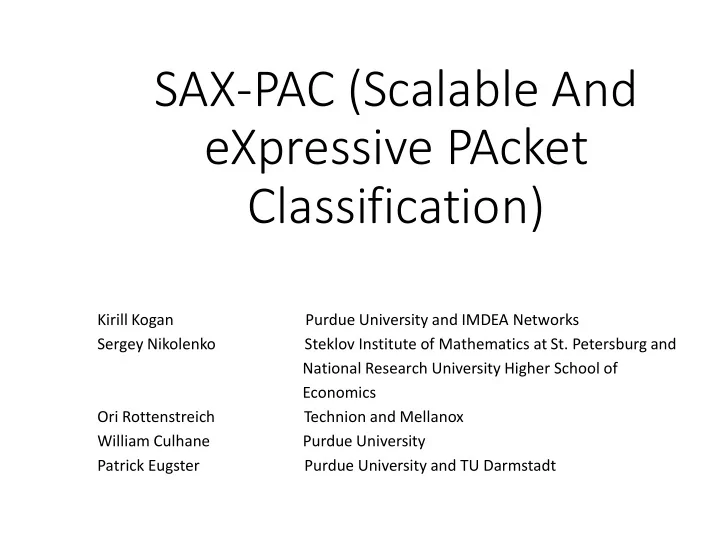

SAX-PAC (Scalable And eXpressive PAcket Classification) Kirill Kogan Purdue University and IMDEA Networks Sergey Nikolenko Steklov Institute of Mathematics at St. Petersburg and National Research University Higher School of Economics Ori Rottenstreich Technion and Mellanox William Culhane Purdue University Patrick Eugster Purdue University and TU Darmstadt
Outline • Current state of the art in packet classification • Impact of structural properties on representation efficiency • Classifiers as Boolean expressions • Proposed solutions • Evaluation • Summary and future work 2
Representation of expressiveness on data plane S 2 S 1 control plane Southbound API data plane priority 3
SW-based vs. TCAM-based solutions SW-based: 𝑂 = 4 rules 𝐿 = 2 fields prefixes ranges Memory Lookup time 𝑃(𝑚𝑝 𝑙−1 𝑂) 𝑃(𝑂) 𝑃(𝑂 𝑙 ) 𝑃(𝑚𝑝𝑂) TCAM-based: 𝑂 = 3 rules 𝐿 = 3 prefixes ranges Encoding #TCAM entries Binary 42+28+50=120 Gray 24+8+32=64 4
Order-independence If the rules of a classifier do not ``intersect’’, their order is not important. • Example: prefixes of the same length • Implicit creation of order-dependence for service policies cisco1 cisco2 cisco3 fw ipc acl Order-independent rules 120 249 329 39962 48294 49779 Total 148 269 364 45723 49840 49870 Order-independent % 81 93 90 87 97 99 5
Exploiting order-independence • Adding new fields keep order-independence • At most one rule is matched and it can be false-positive • We can reduce space by skipping new fields #Fields Bin Encoding Gray Encoding 2 6+7+10=23 6+4+8=18 3 42+28+50=120 24+8+32=64 6
Fields subset minimization (FSM) Problem 1: Find a maximal subset 𝑁 of fields of an order- independent classifier 𝐿 s.t. 𝐿 −𝑁 is order-independent Fields Binary Encoding Gray Encoding 1,2,3 42+28+50=120 24+8+32=64 1,2 6+7+10=23 6+4+8=18 1 2+1+2=5 2+1+2=5 7
Multi-group Representation A classifier 𝐿 is irreducible or order-dependent? Problem 2: Given a classifier 𝐿 on 𝑙 fields and 0 < 𝑚 < 𝑙 . Find an assignment of rules to a minimal number of disjoint groups s.t. every group is order-independent on 𝑚 fields. 8
Multi-group representation of rules subset Number of groups > supported level of parallelism 𝛾 ? Problem 3: Given a classifier 𝐿 on 𝑙 fields, 0 < 𝑚 < 𝑙 , and 𝛾 > 0 . Find an assignment of a maximal subset of rules to 𝛾 disjoint groups s.t. every group is order-independent on 𝑚 fields. Max order-independent set on 3 fields 9
Classifiers as Boolean expressions MinDNF : For a given Boolean function 𝑔 , find a minimal size of DNF for 𝑔 FSM with per FSM with per MinDNF : field resolution: bit resolution: 10
Exact algorithm FSM is NPC (reduction from SetCover) Theorem : 𝐺𝑇𝑁𝐶𝑗𝑜𝑇𝑓𝑏𝑠𝑑ℎ 𝑙, 0, 𝑙 − 1 runs in time 𝑃(𝑙2 𝑙−1 𝑂 2 ) 11
Approximate algorithms Heuristics: algorithms for 𝑇𝑓𝑢𝐷𝑝𝑤𝑓𝑠 and 𝑁𝑏𝑦𝑇𝑓𝑢𝐷𝑝𝑤𝑓𝑠𝑏𝑓 Define 𝑙 𝑡𝑓𝑢𝑡 𝑇 1 , . . , 𝑇 𝑙 (one per field) to cover 𝑉 𝑇 𝑗 , 1 ≤ 𝑗 ≤ 𝑙, contains all pairs of rules that do not intersect in this field Theorem : 𝐺𝑇𝑁 is reducible to 𝑇𝑓𝑢𝐷𝑝𝑤𝑓𝑠 in 𝑃(𝑙𝑂 2 ) time with approximation factor 2 ln 𝑂 + 1 12
Evaluation 6 classifiers with real parameters (see paper for more examples) # Max OI part Multi-group representation 5 fields Total 1-field groups 2-field groups ≤ 2 ≤ 5 ≤ 2 ≤ 5 rules OI FSM {0,1} all 95% 99% all 95% 99% size 8 1 584 538 0,1,3,4 406 15 13 2 8 10 4 7 3 4 2 269 249 0,1,4 246 4 2 3 1 1 2 2 2 0 0 3 364 329 0,1,3,4 324 7 3 5 2 4 4 2 3 1 14 4 49870 49779 0,1,4 49768 16 1 1 6 9 12 1 1 5 7 5 47276 44178 0,1,3,4 43819 67 5 13 19 32 39 2 5 10 20 6 48885 48826 0,1,2,4 48755 20 3 3 15 15 12 1 1 5 9 13
Summary • Semantically equivalent: more fields imply less efficient representation • Representation with false-positive: more fields – more efficient representation • Structural properties can significantly improve time-space trade-off • No restrictions on representation of every group (we define only additional abstraction layer) 14
Ongoing and future work • Consider special cases as a FIB representation G. Retvari et al., Compressing IP Forwarding Tables: Towards Entropy Bounds and Beyond SIGCOMM 13 • Identify additional structural properties • Composition of structural properties • Application to neighboring fields: data bases, program optimization, etc. 15
Thank you 16
Recommend
More recommend